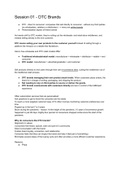Summary
Consumer Marketing Complete Summary + Relevant Academoc Articles
- Course
- Institution
Here you'll be able to find an 86-page comprehensive document that explains in detail every topic addressed during the Consumer Marketing course. The content is written in bullet points and has many graphics, tables, and images. These visualizations aid comprehension of the material and provide an ...
[Show more]












